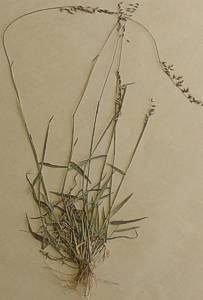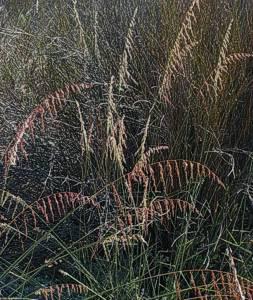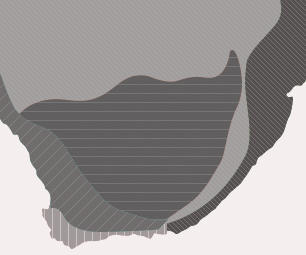Ehrharta calycina
Ehrharta calycina Sm.
Family: Poaceae
Common names: common ehrharta, common veld grass (Eng.); gewone ehrharta, rooigras, polgras (Afr.)
Introduction
Ehrharta calycina is usually perennial with strongly geniculate culms (stems), red-flowers and a creeping, branched rhizome.

Description
Description
Ehrharta calycina is a very variable perennial, rarely annual, 300-700(-1800) mm high, often rhizomatous.
The leaf blade is up to 7 mm wide, expanded or rolled and filiform (thread-like). The spikelet is 4.0-8.5 mm long; glumes (the bracts at the base of the spikelet) ± equal, shorter than the spikelet; the sterile lemmas are similar in texture, the sides long-hairy; the first sterile lemma is more than 2/3 as long as the second sterile lemma; the second sterile lemma has an acute or truncate apex, commonly with a mucro or minute awn arising abruptly from the central vein, and a pair of ear-like appendages at the base; the anther is 2.8-6.0 mm long.

Flowering time: July to Dec, but mainly in spring.


Conservation Status
Status
Ehrharta calycina, is common and widespread, and is good for grazing, so conservation is practised indirectly. It is assessed as Least Concern (LC) on the Red List of South African Plants.
Distribution and habitat
Distribution description
Ehrharta calycina is native to southern Africa, and occurs in the Northern and Western Cape, Free State, Eastern Cape and KwaZulu-Natal, and from. It was introduced to Australia and California, and in the USA as a pasture grass where it is now considered an invasive weed. It is adapted to a large variety of habitats, but usually prefers disturbed areas and sandy soils. It is a common winter-rainfall grass.

Derivation of name and historical aspects
History
Ehrharta calycina was named for Friedrich Ehrhart (1742-1795), a Swiss apothecary and botanist. The species name calycina is derived from the Latin word meaning belonging to or like a calyx. The genus Ehrharta has ± 35 species that occur in southern Africa and northwards to Ethiopia and Yemen, with 22 species in South Africa. It is naturalized in Indonesia, New Zealand and Australia.
Ecology
Ecology
Ehrharta calycina has many habitats and soil types. It favours sandy soils in the succulent veld of arid areas, but is also widespread in other types of vegetation, occasionally dominant in large patches, especially in disturbed veld. It is pollinated by wind and also seeds are dispersed by wind.
Uses
Use
Ehrharta calycina is a good grazing grass in the more arid regions. Local strains have been tested for forage value, this species being one of the few winter-rainfall grasses that is valuable for grazing. In the past it was used to rehabilitate mine dumps. It is a persistent weed in some parts of Australia and in California is considered an invasive alien.
Growing Ehrharta calycina
Grow
Ehrharta calycina is best used in a garden as an ornamental, as it is evergreen. It tends to grow both in height and in width, giving rise to a rounded shrub. It is easy to cultivate, not forgetting its watering and nutritional needs: always leave the soil dry for a few days. It is good to practise a preventative treatment, using a wide-range insecticide, which should be applied when the grass is not flowering.
References
- Chippindall, L.K.A. & Crook, A.O. 1976. Grasses of southern Africa. Collins, Harare [ Salisbury ].
- Gibbs Russell, G.E., Watson, L., Koekemoer, M., Smook, L., Barker, N.P., Anderson, H.M. & Dallwitz, M.J. 1990. Grasses of southern Africa. Memoirs of the Botanical Survey of South Africa No. 58.
- Leistner, O.A. (ed.). 2000. Seeds plants of southern Africa : families and genera. Strelitzia 10. National Botanical Institute, Pretoria.
- Van Oudtshoorn, F. 1999. Guide to the grasses of southern Africa. Briza Publications, Pretoria.
Credits
Aluoneswi Caroline Mashau
National Herbarium
September 2008
Plant Attributes:
Plant Type: Bi/Annual, Grass, Perennial
SA Distribution: Eastern Cape, Free State, KwaZulu-Natal, Northern Cape, Western Cape
Soil type: Sandy, Loam
Flowering season: Spring, Early Summer, Winter
PH: Acid, Neutral
Flower colour: Red
Aspect: Full Sun, Shade
Gardening skill: Easy
Special Features:
Horticultural zones









Rate this article
Article well written and informative
Rate this plant
Is this an interesting plant?
Login to add your Comment
Back to topNot registered yet? Click here to register.